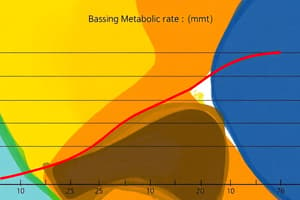Podcast
Questions and Answers
Which of the following best explains why VO2 increases during exercise?
Which of the following best explains why VO2 increases during exercise?
- The body requires less oxygen during initial stages of exercise, and VO2 increases to meet this need.
- VO2 is not impacted by the type of activity performed and how intensely the body performs.
- Exercise utilizes bodily systems requiring oxygen, thus VO2 increases with energy expenditure. (correct)
- Exercise decreases the body's need for oxygen, leading to increased VO2 to compensate.
During intense exercise, the ATP-PC system is primarily utilized. Where in the cell does this metabolic system operate?
During intense exercise, the ATP-PC system is primarily utilized. Where in the cell does this metabolic system operate?
- Endoplasmic Reticulum
- Mitochondria
- Nucleus
- Sarcoplasm (correct)
How does open-circuit spirometry indirectly measure energy expenditure?
How does open-circuit spirometry indirectly measure energy expenditure?
- By directly measuring heat production.
- By measuring the amount of protein consumed.
- By measuring the pH levels in the blood.
- By assessing the amount of oxygen consumed. (correct)
Which statement accurately describes the relationship between catabolic and anabolic reactions in metabolism?
Which statement accurately describes the relationship between catabolic and anabolic reactions in metabolism?
How can training influence enzyme efficiency in metabolic pathways?
How can training influence enzyme efficiency in metabolic pathways?
Flashcards
Energy Expenditure
Energy Expenditure
The energy your body uses for work, measured by heat produced or oxygen consumed.
Open-Circuit Spirometry
Open-Circuit Spirometry
Measures oxygen consumption (VO2) by analyzing exhaled air volume.
VO2
VO2
The amount of oxygen consumed; increases with exercise intensity due to higher energy demands.
Metabolism
Metabolism
Signup and view all the flashcards
ATP-PC System
ATP-PC System
Signup and view all the flashcards
Study Notes
- Energy expenditure is the energy the body uses to perform work
- It can be directly measured by the amount of heat created, indicating calories burned
- Energy expenditure can also be indirectly measured by the amount of oxygen consumed (VO2 max)
Open-Circuit Spirometry
- Determines VO2 by measuring the amount of oxygen consumed
- VO2 = VE (volume expired)
VO2
- VO2 represents the amount of oxygen consumed
- It increases during exercise because the body uses systems that require oxygen
- The increase is proportional to the amount of energy expended
Metabolism
- Metabolism encompasses all chemical reactions in the body
Catabolic Reactions
- Decompose molecules
- Release energy (exergonic)
Anabolic Reactions
- Synthesize molecules
- Consume energy (endergonic)
Coupled Reactions
- Reactions that drive secondary reactions
Molecules Involved in Metabolism
- ATP is the energy currency of the cell
- FAD is reduced to FADH2
- NAD is reduced to NADH
Enzymes
- Act as catalysts in cellular reactions
- Highly specific and very efficient
- Subject to cellular controls like temperature, pH, and substrate concentration
- Training can influence enzyme efficiency
ATP-PC System
- Occurs in the sarcoplasm
- Most rapid and simple ATP production method
- Used at the onset of exercise or during high-intensity efforts
Studying That Suits You
Use AI to generate personalized quizzes and flashcards to suit your learning preferences.




